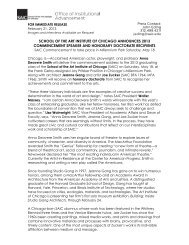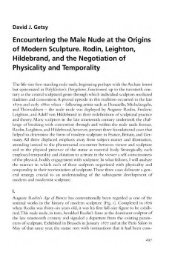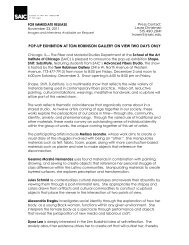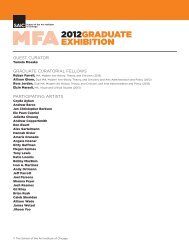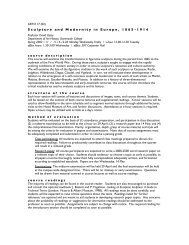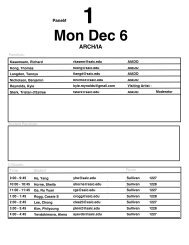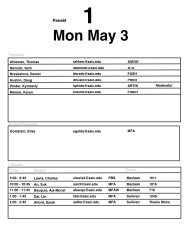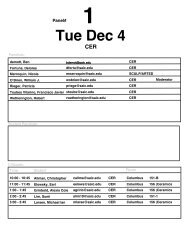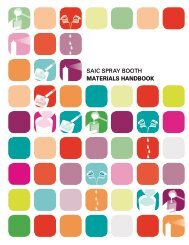i. institutional support and commitment to continuous improvement
i. institutional support and commitment to continuous improvement
i. institutional support and commitment to continuous improvement
Create successful ePaper yourself
Turn your PDF publications into a flip-book with our unique Google optimized e-Paper software.
School of the Art Institute of Chicago<br />
Department of Architecture, Interior Architecture, <strong>and</strong> Designed Objects<br />
Master of Architecture<br />
Master of Architecture with emphasis in Interior Architecture<br />
Course Number & Title:<br />
ARCH & INARC 5123 Matter <strong>and</strong> Structures 2 (4.5)<br />
Course Description:<br />
This seminar introduces building materials <strong>and</strong> their<br />
applications. The structures component of the<br />
course addresses <strong>to</strong>pics related <strong>to</strong> the strength of<br />
materials.<br />
Course Goals & Objectives:<br />
1) Design practice: an underst<strong>and</strong>ing of the role<br />
that materials play in design decisions developed<br />
through a series of case studies of his<strong>to</strong>ric <strong>and</strong><br />
contemporary buildings.<br />
2) Building science skills: develop the ability <strong>to</strong><br />
communicate basic material performance in<br />
technical drawings, through plans, sections, wall<br />
sections <strong>and</strong> details.<br />
3) Building science knowledge: an introduction<br />
<strong>to</strong> the performance of building materials in the<br />
broadest sense, including design performance,<br />
technical performance, embodied energy <strong>and</strong> life-<br />
cycle performance.<br />
4) Structures knowledge: Delivers an underst<strong>and</strong>-<br />
ing of structural concepts such as the distribution<br />
of concentrated <strong>and</strong> uniform loads, vertical loads<br />
<strong>and</strong> the resistance of lateral loads.<br />
Student Performance Criterion:<br />
1) Best exemplifies the following criteria:<br />
a) B.12. Building Materials <strong>and</strong> Assemblies<br />
(underst<strong>and</strong>ing)<br />
2) Additional Criteria<br />
a) A.4. Technical documentation (ability)<br />
b) A.7. Use of Precedent (ability)<br />
c) B.9. Structural systems (underst<strong>and</strong>ing)<br />
d) B.10. Building materials (underst<strong>and</strong>ing)<br />
e) C.1. Collaboration (ability)<br />
Topical Outline:<br />
1) Design practice: After a series of brief investiga-<br />
tions <strong>and</strong> two case studies, students articulate the<br />
rationale for material choices for a series of his<strong>to</strong>ric<br />
<strong>and</strong> contemporary buildings in short, written<br />
analysis <strong>and</strong> descriptions, achieving a professional<br />
level of accomplishment; 10% of the course.<br />
2) Building science skills: Through documentation<br />
<strong>and</strong> case studies of his<strong>to</strong>ric <strong>and</strong> contemporary<br />
buildings, students learn <strong>to</strong> read <strong>and</strong> produce<br />
basic technical drawings, including plans, sections<br />
<strong>and</strong> details; 25% of the course.<br />
Architecture Program Report | 170<br />
3) Building science knowledge: through readings<br />
<strong>and</strong> lectures, students develop an underst<strong>and</strong>ing<br />
of the range <strong>and</strong> application of building materials,<br />
<strong>and</strong> demonstrate their underst<strong>and</strong>ing through a<br />
series of quizzes <strong>and</strong> an exam, achieving a grade<br />
of at least 80%; 30% of the course.<br />
4) Structures skills: Delivers an ability <strong>to</strong> identify<br />
the distribution of loads though a structure of<br />
columns, beams, <strong>and</strong> shear walls, <strong>to</strong> determine the<br />
safe member sizes for columns <strong>and</strong> retaining walls,<br />
including eccentric loads <strong>and</strong> overturning mo-<br />
ments. Topics include including lateral loads due <strong>to</strong><br />
wind <strong>and</strong> earthquakes, moment connections, shear<br />
walls, <strong>and</strong> appropriate systems design with good<br />
practice rules of thumb for a variety of related<br />
loading situations. 35% of the course.<br />
Prerequisites:<br />
All required first semester courses.<br />
Textbooks/Learning Resources:<br />
Various sources including:<br />
• Materials for Design, by Vic<strong>to</strong>ria Bell<br />
• The Idea of Lasting, by Rafael Moneo from<br />
A Conversation with Rafael Moneo in<br />
Perspecta<br />
• Thermal Bath at Vals, by Peter Zumthor<br />
Offered (semester <strong>and</strong> year):<br />
• Semester: SPRING<br />
• Year: ONE<br />
Faculty assigned:<br />
• 2009-2010 academic year:<br />
Grimes, Ellen (F/T), Dean, Paul (P/T),<br />
Koenigs, Mark (P/T), Rehmanjee, Yasmin<br />
(P/T)<br />
• 2010-2011 academic year:<br />
Sullivan, Anne (F/T), Sosin, Nate (P/T),<br />
Dean, Paul (P/T), Rehmanjee, Yasmin (P/T)



